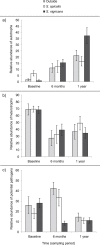Coral transplantation triggers shift in microbiome and promotion of coral disease associated potential pathogens
- PMID: 26144865
- PMCID: PMC4491727
- DOI: 10.1038/srep11903
Coral transplantation triggers shift in microbiome and promotion of coral disease associated potential pathogens
Abstract
By cultivating turf algae and aggressively defending their territories, territorial damselfishes in the genus Stegastes play a major role in shaping coral-algal dynamics on coral reefs. The epilithic algal matrix (EAM) inside Stegastes' territories is known to harbor high abundances of potential coral disease pathogens. To determine the impact of territorial grazers on coral microbial assemblages, we established a coral transplant inside and outside of Stegastes' territories. Over the course of one year, the percent mortality of transplanted corals was monitored and coral samples were collected for microbial analysis. As compared to outside damselfish territories, Stegastes were associated with a higher rate of mortality of transplanted corals. However, 16S rDNA sequencing revealed that territorial grazers do not differentially impact the microbial assemblage of corals exposed to the EAM. Regardless of Stegastes presence or absence, coral transplantation resulted in a shift in the coral-associated microbial community and an increase in coral disease associated potential pathogens. Further, transplanted corals that suffer low to high mortality undergo a microbial transition from a microbiome similar to that of healthy corals to that resembling the EAM. These findings demonstrate that coral transplantation significantly impacts coral microbial communities, and transplantation may increase susceptibility to coral disease.
Figures





References
-
- Garren M. & Azam F. New directions in coral reef microbial ecology. Environ. Microbiol. 44, 833–833 (2012). - PubMed
-
- Ainsworth T. D., Vega Thurber R. & Gates R. D. The future of coral reefs: a microbial perspective. Trends Ecol. Evol. 25, 233–240 (2009). - PubMed
-
- Knowlton N. & Rohwer F. Multispecies microbial mutualisms on coral reefs: The host as a habitat. Am. Nat. 162, S51–S62 (2003). - PubMed
-
- Vega Thurber R. et al. Metagenomic analysis of stressed coral holobionts. Environ. Microbiol. 11, 2148–2163 (2009). - PubMed
Publication types
MeSH terms
Substances
Associated data
LinkOut - more resources
Full Text Sources
Other Literature Sources
Research Materials

